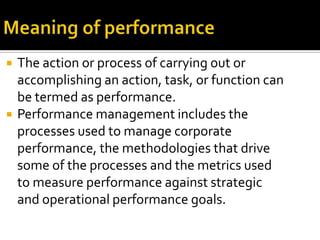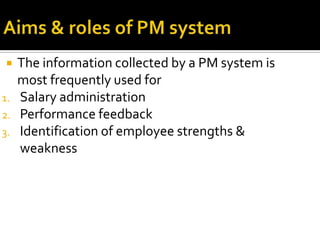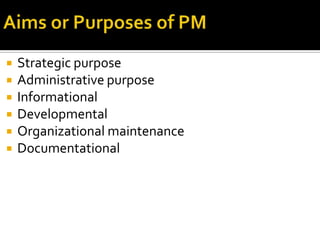Performance management
- 2. Definition of performance & PM Characteristics of an ideal PM systems Aims and role of PM PM process PM & HR Strategic planning in PM
- 3. Be treated fairly and consistently Job/career enrichment opportunities Clear expectations Positive/constructive feedback on a regular basis Involvement in goal setting Economic reward
- 4. To reach organizational mission and goals Encourage and reward behaviors aligned with organizational mission and goals Curb or redirect non- productive activities
- 5. The action or process of carrying out or accomplishing an action, task, or function can be termed as performance. Performance management includes the processes used to manage corporate performance, the methodologies that drive some of the processes and the metrics used to measure performance against strategic and operational performance goals.
- 6. What are Performance Standards? Performance Standards are the benchmark against which performance is measured.
- 7. “It is a continuous process of identifying, measuring and developing the performance of individuals and teams and aligning performance with the strategic goals of the organization”. PM contains two major components: 1. It’s a continuous process 2. Alignment with strategic goals
- 8. Performance management (PM) includes activities that ensure that goals are consistently being met in an effective and efficient manner. Performance management focuses on the performance of an organization, a department, employee, or even the processes to build a product or service or any other areas in an organization.
- 9. An iterative process of goal-setting, communication, observation and evaluation to support, retain and develop exceptional employees for organizational success. PM Set Goals Commu nicate Observe Evaluate
- 10. It serves the strategic purpose of the org. Provide information for reward system Facilitates HR decisions Enabling employees to learn about their performance as against org expectations It serves as a developmental purpose Serves org maintenance purpose Support HR decision to meet legal requirements
- 11. Both are different concepts. PM is a broader term & includes appraisal as a part of the performance system. Performance appraisal is the systematic description of an employee’s strengths and weakness. Thus, performance appraisal is an important component of performance management.
- 12. Motivation to perform is increased Increases self esteem Managers gain insight about subordinates Jobs are simplified Organizational goals are clear Employees become more competent Differentiation b/n good & poor performance Performances are communicated Change can be possible
- 13. Strategic congruence Thoroughness Practicality Meaningfulness Specificity Reliability Validity Acceptability Inclusiveness Openness Correctability Standardization Ethicality Identification of effective & ineffective performance
- 14. The information collected by a PM system is most frequently used for 1. Salary administration 2. Performance feedback 3. Identification of employee strengths & weakness
- 15. Strategic purpose Administrative purpose Informational Developmental Organizational maintenance Documentational
- 16. Increased turnover Use of misleading information Wasted time & money Lowered self esteem Damaged relationships Decreased motivation to perform Employee job burnout & dissatisfaction
- 17. Increased risk of litigation Unjustified demands on managers & employees resources Varying & unfair stds & ratings Emerging biases Unclear rating systems
- 18. Prerequisites Performance Planning Performance Execution PerformanceAssessment Performance Review Performance Renewal & Re-contracting PM PM PM PM PM PM
- 19. Two important prerequisites before PM system are: 1. Knowledge of the org’s mission & strategic goals 2. Knowledge of the job in question (this is done through job analysis)
- 20. Employees should have a through knowledge of the PM System. Planning discussion includes : 1. Results 2. Behaviours 3. Developmental issues
- 21. At the execution stage, following factors must be considered: 1. Commitment to goal achievement 2. Ongoing performance feedback & coaching 3. Communication 4. Collecting & sharing performance data 5. Preparing for performance reviews
- 22. It is important for employee as well as the managers to take ownership of assessment process. It helps the org to use the information obtained in a productive manner for the future requirements. Inclusion of self appraisal is also beneficial in all manner.
- 23. Review stage involves meeting between employees & the manager. This meeting is calledAppraisal Meeting. Review meeting helps employee and manager to design developmental plans.
- 24. Its identical to planning stage. Manager uses the insights & information gained from other phases to reset performance goals for employees























